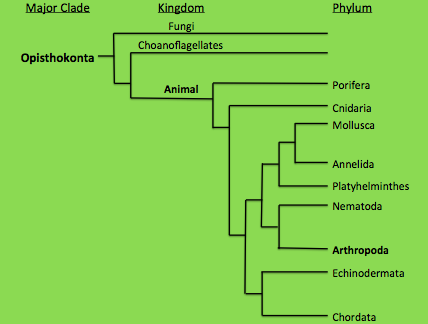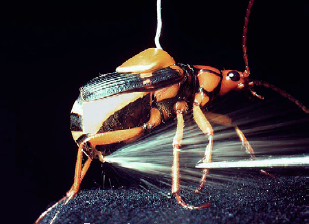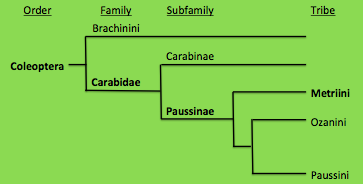Classification
Before extrapolating on the details of classification, it should first be
establ ished what the implications of these main categorizations
are. It should also be noted that traits associated with
groupings were all at some point in the ancestry present in the
organism. The domain Eukarya consists of a multitude of major
clades including all kinds of life forms. Some unifying traits
of this large group are
cytoskeletons, nuclei in cells, and
organelles such as mitochondria which evolved from an
endosymbios with
bacteria (Tree of life 2009). The Tree of
Life (2009) also discusses the kingdom of Metrius contractus. It
is in the Animal Kingdom meaning it is part of the major
Eukaryotic clade of Opisthokonta, has some type of posterior
flagellated cell, and is multicellular.
ished what the implications of these main categorizations
are. It should also be noted that traits associated with
groupings were all at some point in the ancestry present in the
organism. The domain Eukarya consists of a multitude of major
clades including all kinds of life forms. Some unifying traits
of this large group are
cytoskeletons, nuclei in cells, and
organelles such as mitochondria which evolved from an
endosymbios with
bacteria (Tree of life 2009). The Tree of
Life (2009) also discusses the kingdom of Metrius contractus. It
is in the Animal Kingdom meaning it is part of the major
Eukaryotic clade of Opisthokonta, has some type of posterior
flagellated cell, and is multicellular.
 Getting a bit more specific, this organism is part of the
Arthropoda Phylum. The Bug Guide (2013) discusses that organisms
in this phylum have jointed pairs of legs, bodies divided into
segments, and
exoskeletons commonly made of
chitin. The
evolution of the exoskeleton in this group of organisms was really quite
critical in their ability to develop well-suited mouth parts,
limbs, outstanding agility, and other special adaptations (Eisner
and Meinwald 1995). Metrius contractus is in the Insecta Class
(Tree of life 2009). These organisms have bodies and legs in
parts of three, and most also have compound eyes and wings (Bug
Guide 2013). The next level, order, is specifically for beetles
which have a leathery exterior, reduced wing structures, and a
larval stage (Bug Guide 2013). This order is called Coleoptera
(Bug Guide 2013).
Getting a bit more specific, this organism is part of the
Arthropoda Phylum. The Bug Guide (2013) discusses that organisms
in this phylum have jointed pairs of legs, bodies divided into
segments, and
exoskeletons commonly made of
chitin. The
evolution of the exoskeleton in this group of organisms was really quite
critical in their ability to develop well-suited mouth parts,
limbs, outstanding agility, and other special adaptations (Eisner
and Meinwald 1995). Metrius contractus is in the Insecta Class
(Tree of life 2009). These organisms have bodies and legs in
parts of three, and most also have compound eyes and wings (Bug
Guide 2013). The next level, order, is specifically for beetles
which have a leathery exterior, reduced wing structures, and a
larval stage (Bug Guide 2013). This order is called Coleoptera
(Bug Guide 2013).
 Following order is the family which is
Carabidae. This family is made up of all bombardier beetles
(Eisner et al. 1977).
What is a bombardier beetle? Bombardier beetles make up
the family Carabidae but also the Brachinini family (Eisner et
al. 1977). These beetles all excrete an irritating
quinone
solution from powerful chemical jets in their
posterior abdomen
regions (Eisner et al. 2000). These tiny jets
essentially comprise little bombs that are always ready for the
defense of the beetle (Schwarcz 2010). This is where the name
bombardier beetle came from (Schwarcz 2010).
Following order is the family which is
Carabidae. This family is made up of all bombardier beetles
(Eisner et al. 1977).
What is a bombardier beetle? Bombardier beetles make up
the family Carabidae but also the Brachinini family (Eisner et
al. 1977). These beetles all excrete an irritating
quinone
solution from powerful chemical jets in their
posterior abdomen
regions (Eisner et al. 2000). These tiny jets
essentially comprise little bombs that are always ready for the
defense of the beetle (Schwarcz 2010). This is where the name
bombardier beetle came from (Schwarcz 2010).
Now getting back on topic and more specifically into the focus
organism, it is in the Metrius Genus. All of the beetles in this
genus are black and emit a clouded spray of defense when
threatened (Bug Guide 2013). Finally, the species of Metrius
contractus is reached! . Its tiny size is probably where it got
the name Metrius
contractus. The Latin root meta means a change in form, and
contractus means narrow or restricted (Learn That Word 2005). Often this spectacular organism is lump
summed into the common and larger grouping of bombardier beetle,
but such a general grouping doesn’t quite do it justice. To dive
into more details on the species, explore
habitat, geography, & interactions,
reproduction, or even some crazy
chemistry!
After understanding the basics, it is time to dig into the more
extensive classifying divisions of some of these large groups.
As mentioned earlier, the two families in the generalized
bombardier beetle group are Carabidae a nd Brachinini (Eisner
et
al. 2000). Inside of the Carabidae family are the subfamilies
Carabinae and Paussinae (Eisner et al. 2000). There are
also
three main tribes that are included in the Paussinae subfamily
called Metriini, Ozanini, and Paussini (Eisner et al. 1977).
This being said, Metrius contractus is part of the Carabidae
family, the Paussinae subfamily, and in the Metriini tribe.
Given that there are only three species known in the Metriini
tribe including Metrius contractus, there is still much
information to be uncovered about it and its evolutionary
connectedness to other organisms (Eisner et al. 2000). The most
prevalent and accepted hypothesis is that the Metrius Genus is
representative of more primitive beetles. The true debate in the
phylogeny of bombardier beetles lies in whether or not their
ability to chemically bomb predators is a
homologous trait or
the result of
convergent evolution
(Eisner et al. 1977). As
research advances, however, it is becoming quite clear that
there was likely a single common ancestor that gave rise to this
trait in the beetles (Eisner et al. 2000).
nd Brachinini (Eisner
et
al. 2000). Inside of the Carabidae family are the subfamilies
Carabinae and Paussinae (Eisner et al. 2000). There are
also
three main tribes that are included in the Paussinae subfamily
called Metriini, Ozanini, and Paussini (Eisner et al. 1977).
This being said, Metrius contractus is part of the Carabidae
family, the Paussinae subfamily, and in the Metriini tribe.
Given that there are only three species known in the Metriini
tribe including Metrius contractus, there is still much
information to be uncovered about it and its evolutionary
connectedness to other organisms (Eisner et al. 2000). The most
prevalent and accepted hypothesis is that the Metrius Genus is
representative of more primitive beetles. The true debate in the
phylogeny of bombardier beetles lies in whether or not their
ability to chemically bomb predators is a
homologous trait or
the result of
convergent evolution
(Eisner et al. 1977). As
research advances, however, it is becoming quite clear that
there was likely a single common ancestor that gave rise to this
trait in the beetles (Eisner et al. 2000).

Use this figure to help you summarize some of those complicated
classifications or click on any of the phyogenetic trees to
explore the
Tree of Life a
bit more!
Move on to Habitat, Geography, and Interaction!
